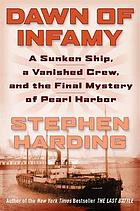
Dawn of Infamy
A Sunken Ship, a Vanished Crew, and the Final Mystery of Pearl Harbor
کتاب های مرتبط
- اطلاعات
- نقد و بررسی
- دیدگاه کاربران
نقد و بررسی

October 15, 2016
The story of the first ship sunk by a Japanese submarine that demonstrates the careful planning and remarkable success of the surprise attack on Pearl Harbor.In 1940, the Cynthia Olson was acquired by the Olson Steamship Company and ran coastal service from Portland to Los Angeles. As war approached, the company won an Army Transportation Services contract to ship lumber, and eventually the ship was certified for service on the open ocean, which allowed for runs to Hawaii, where the United States was building in anticipation of the coming conflict. Though Military History editor-in-chief Harding (Last to Die: A Defeated Empire, a Forgotten Mission, and the Last American Killed in World War II, 2015, etc.) is fond of cliffhanger endings that eventually outstay their welcomes, he narrates an interesting tale. The captain and first mate on the fateful Dec. 7, 1941, voyage were experienced, but it seems to have made little difference. When the Japanese submarine surfaced and fired a shot across the bow, the intent was to humanely allow the crew to escape before the ship was sunk. The captain, a World War I veteran, knew just what was expected. He cut his engines, and after a second shot from the sub, he put his crew into lifeboats, and they rowed as far away from the ship as possible. It seems like a simple enough story, but Harding explores three crucial questions. First, did the sub captain truly wait to fire on the Cynthia Olson until the attack on Pearl Harbor was underway? Second, would knowledge of this attack have enabled a better defense with even an hour notice? Third, what really happened to the crew? The author traces facts that were discovered years--even decades--after the event, uncovers interviews with the Japanese captain and crew, and comes up with a number of intriguing scenarios. A detailed, well-researched book presented in a logical fashion--will appeal most to Pearl Harbor scholars and those interested in submarine warfare.
COPYRIGHT(2016) Kirkus Reviews, ALL RIGHTS RESERVED.

September 15, 2016
Japan's declaration of war, the attack on Pearl Harbor, started just before eight o'clock in the morning (Hawaii-Aleutian Time) on December 7, 1941. With this latest work, Harding (The Castaway's War) investigates whether a Japanese submarine may have fired some of the first shots of the day, between Seattle and Honolulu. The book, originally published in the UK as Voyage to Oblivion, traces the history of the freighter SS Cynthia Olson from her origin as a military cargo ship built too late to be used in World War I up to her final voyage carrying lumber for the U.S. Army. Harding's thorough research reconstructs the Cynthia Olson's last days through military records and personal narratives of the crew of the I-26, the Japanese submarine that sunk the ship. While the story of the Cynthia Olson often appears as a side note in other histories about Pearl Harbor, this harrowing account brings it to the fore, telling how a Japanese submarine was able to sail close to the U.S. mainland and sink an unarmed ship in the hours before America entered World War II. VERDICT Harding's detailed history of the Cynthia Olson and her connection to Pearl Harbor will appeal to nautical and military historians alike.--John Rodzvilla, Emerson Coll., Boston
Copyright 2016 Library Journal, LLC Used with permission.

November 1, 2016
Harding (The Castaway's War, 2016) presents readers with a genuine treasure in this long-overlooked story from the earliest hours of America's entry into WWII. On December 7, 1941, the Cynthia Olson, a small cargo ship under military contract, was en route to Pearl Harbor from Seattle with a load of lumber, 35 merchant marines, and 2 U.S. soldiers. Moments after the first Japanese aircraft launched the attack on Hawaii, the Cynthia Olson was sunk by an enemy submarine, with all hands lost. With only a brief transmission alerting others to its fate, the ship vanished, leaving behind no evidence of its destruction. Although mentioned in the first days of the war in conjunction with the Pearl Harbor attacks, the little cargo vessel and its crew were soon forgotten by everyone except the grieving families and a few determined Hawaiian newspaper journalists. Based on impressive research into both the American and Japanese perspectives, Harding's painstaking and determined effort to bring the Cynthia Olson and its crew back to their moment of historic significance, and celebrate the earlier work of those who kept the story alive, is not only admirable but makes for truly interesting history. A compelling narrative that will appeal to war buffs, fans of nautical history, and everyone interested in reclaimed true tales.(Reprinted with permission of Booklist, copyright 2016, American Library Association.)

























دیدگاه کاربران